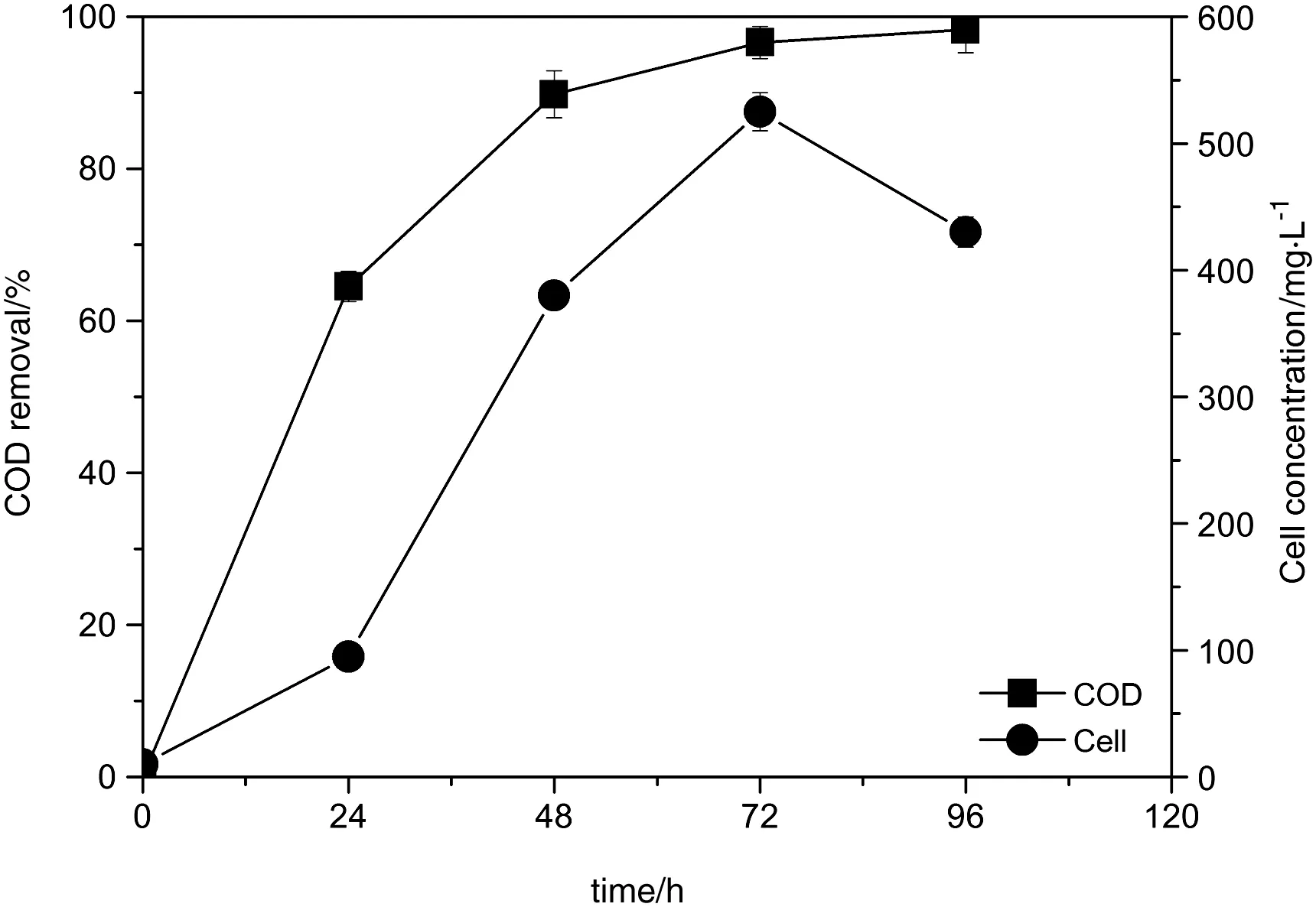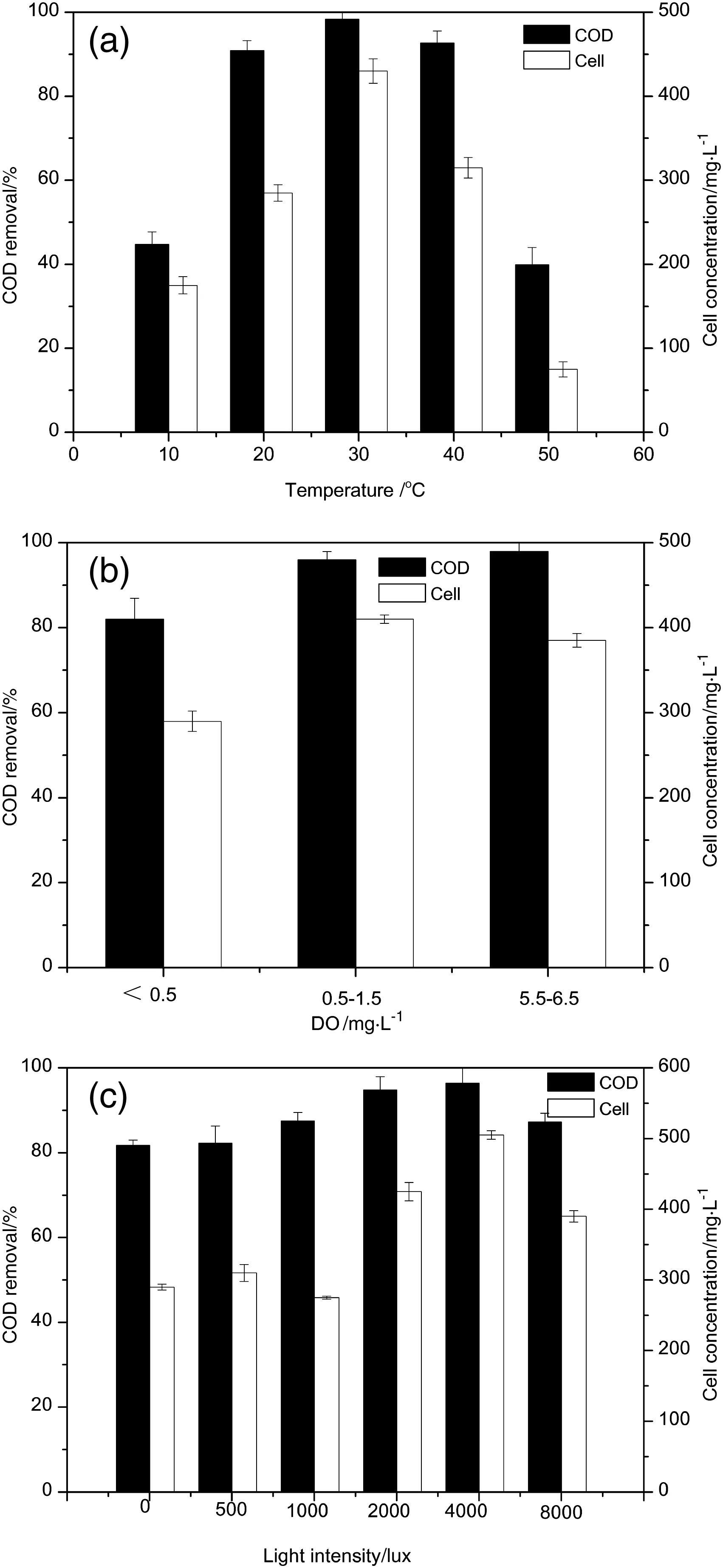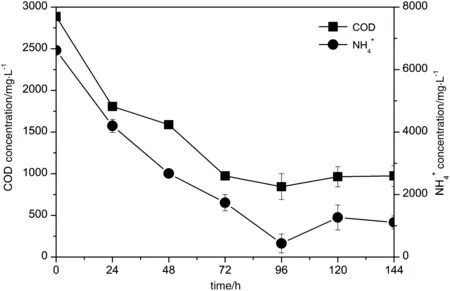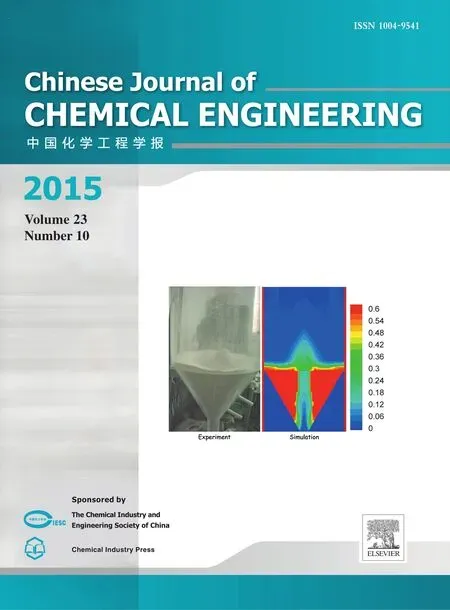Biological treatment of high wastewater using an ammonia-tolerant photosynthetic bacteria strain(ISASWR2014)☆
Qin Zhou,Guangming Zhang,Xiang Zheng,Guohua Liu
School of Environment&Natural Resource,Renmin University of China,Beijing 100872,China
Keywords:High wastewater C/N Photosynthetic bacteria Chicken manure wastewater
ABSTRACT Wastewater with high is dif ficult to treat by traditional methods.So in this paper,a wild strain of photosynthetic bacteria was used for high wastewater treatment together with biomass recovery.Isolation,identi fication,and characterization of the microorganism were carried out.The strain was inoculated to the biological wastewater treatment unit.The impacts of important factors were examined,including temperature,dissolved oxygen,and light intensity.Results showed that photosynthetic bacteria could effectively treat highN wastewater.For wastewater with of 2300 mg·L-1,COD/N=1.0,98.3%of CODwas removed,and cell concentration increased by 43 times.The optimal conditions for the strain's cell growth and wastewater treatment were 30 °C,dissolved oxygen of 0.5-1.5 mg·L-1 and a light intensity of 4000 lx.Photosynthetic bacteria could bear a lower C/N ratio than bacteria in a traditionalwastewatertreatment process,but the removal was only 20%-40%because small molecule carbon source was used prior to .Also,the use of photosynthetic bacteria in chicken manure wastewater containingabout7000 mg·L-1 proved thatphotosynthetic bacteria could remove in a real case, finally,83.2%of was removed and 66.3%of COD was removed.
1.Introduction
With the rapid development of fertilizer and petrochemical industry,a large number of highwastewater discharged.is usually oxidized to nitrate and nitrite,the nitrate and nitrite usually may cause serious eutrophication,and they are hazardous to humans.Sowastewater treatment is essential for preventing eutrophication and human harm.Highwastewaters,such as piggery wastewater and land fill leachate contain not only high concentrations of nitrogen compounds(up to 1000-3000 mg·L-1)but also high concentrations of organic matter.In highwastewaters,the C/N ration is often quite low and the ammonia concentration is 50-100 times higher than thatin municipal wastewater[1-3].Allthese contributed to the dif ficulty of conventional biological treatment of highwastewaters.
Generally,the most common and cost-ef ficient approach for ammonia wastewater treatment is biological treatment[4,5].However,traditional nitri fication process is not effective in such high ammonia environment with such a low C/N.One reason is that autotrophic bacteria are vulnerable to high concentrations of wastewater with a C/N ratio of 0-2[6].Another reason is that excessive high ammonia exerts a toxic and inhibitory effect on microbial activity[7,8].Thus,traditional nitri fication can be used only after pretreating the wastewater to increase C/N ratio[9]or decrease ammonia concentration of the wastewater[10,11],which greatly increases the operation cost.
Hence,the utilization ofan ammonia-tolerantorganismin biological treatment units seems to be a reasonable approach for highwastewater treatment.Application of photosynthetic bacteria(PSB)might be employed in degrading pollutants in high4wastewater treatment.
PSB are widely distributed in the ocean,lakes,soil and activated sludge also in high-temperature,low-temperature,high-ammonia or low-ammonia environment.They grow in both aerobic and anaerobic light conditions.They are metabolically the most versatile among all prokaryotes[12].PSB have been used to treat a variety of wastewaters such as cadmium wastewater,olive mill wastewater and sul fide containing wastewater[15-19].And using PSB for wastewater treatment has been proven to be a cost effective method.This is because PSB do not only remove pollutants in wastewater,but also accumulate useful materials such as single-cell protein,biopolymers,antimicrobial agents,carotene,pantothenic acid,and therapeutic compounds[13,14].The biomass can be recycled as useful raw materials in food,medical,and agriculture industries.
In this work,a new process was investigated,a strain of PSB isolated from aqua-farm,demonstrated an amazing tolerance to high
The aim of the paper was to study the ability of PSB to treathighwastewater in together with biomass recovery.
2.Materials and Methods
2.1.Isolation and identi fication of ammonia-tolerant microorganism
Aqua-farm water provided the medium for PSB isolation and selection.The bacteria strain was isolated with the medium[12]consisting of DL-malate:4 g·L-1,MgSO4:0.12 g·L-1,(NH4)2SO4:1 g·L-1,CaCl2:0.075 g·L-1,KH2PO3:0.3 g·L-1,Na2EDTA:0.020 g·L-1,VB1:0.001 g·L-1.Nicotinic acid:0.001 g·L-1,Biotin:0.015 g·L-1.Trace element solution,1 ml.The trace element solution contained ZnSO4·7H2O:20 mg·L-1,MnCl2·4H2O:6 mg·L-1,H3BO3:60 mg·L-1,CoCl2·6H2O:40 mg·L-1,and CuCl2·2H2O:2 mg·L-1.pH was 7.0.And the culture was anaerobically at 28-35°C and a light intensity of 2000 lx conditions for 96 h.
The mixed culture was examined microscopically,and it was purified and identi fied according to the biochemical reactions such as catalase test,tolerance to 3%NaCl,gram test,nitrate reduction test,indole test,H2S reaction and spectrum scanning.All experiments were carried out according to Bergey's manual[20].
2.2.Wastewater and reactor operation
The bioreactors were 500 mlglass flasks.These flasks were sterilizedat 121°C for 30 min before use.Each time,400 ml arti ficial highwastewater was added to the bioreactor.PSB were inoculated and the initial cell concentration in wastewater was 10 mg·L-1(dry mass).The amount of PSB was 5%(by volume)in conducted experiments.The arti ficial highwastewater and PSB were rotated at 120 r·min-1with temperature at10,20,30,40,and 50°C,respectively,in the five experimental groups.The dissolved oxygen(DO)was less than 0.5,0.5-1.5,and 5.5-6.5 mg·L-1,respectively;the value was chosen according to previous studies.The illumination intensities were<500,500,1000,2000,4000,and 8000 lux,respectively.
The dissolved oxygen in the controlgroup(<0.5 mg·L-1)condition was realized by microaeration(the purity of nitrogen was 98.0%).After saturated with nitrogen,the bioreactors were sealed with sealing membrane to keep micro-oxygen or anaerobic condition.The dissolved oxygen(DO)of 0.5-1.5 mg·L-1was realized without aeration,and the bioreactor was directly covered with oxygen enriching membranes.The dissolved oxygen of 5.5-6.5 mg·L-1was realized with microaeration(the purity of oxygen was 98.5%).
All experiments were repeated twice.
2.3.Case study
Chicken manure wastewater from a plant was treated biologically using the isolated PSB.The characteristics of the chicken manure wastewater were as below:total COD,total nitrogen(TN),,and TP were about 3000,8000,7000,and 15 mg·L-1,respectively.The pH was about 9.6.
2.4.Analysis
Samples were collected from bioreactors and were centrifuged at 9000 rpm for 10 min.The supernatant was used to test the COD with APHA standard methods[22];the collected PSB were used to measure the biomass(dry mass).The pH was measured using pH tester and the DO was measured using dissolved oxygen meter.The biomass was tested by APHA standard methods.NH4+-N levels were analyzed by the Nesslerization method at an absorbance of 420 nm using a TU-1900 spectrophotometer.
3.Results and Discussions
3.1.Isolation and identi fication of the ammonia-tolerant microorganism
An ammonia-tolerant microorganism was isolated from a eutrophic aqua-farm.The identi fication of bacteria was based on cultural and biochemical characteristics,the results were shown in Table 1.The isolate strain was examined microscopically as gram-negative bacteria.After 48 h culture under anaerobic light conditions,cell suspensions were red and the absorption spectra of living cell suspension showed maximum absorbance peaks at 270,280,375,800,and 860 nm.The main peak at 860 nm was closely related to bacteriochlorin a,and the main peaks at 280,375,and 800 nm were closely related to carotenoids.The contained pigments of the isolate were characteristics of purple non-sulfur photosynthetic bacteria[12].Also the strain was able to grow in the presence of 3%NaCl.The strain had a negative indole reaction,H2S positive and catalase-positive in the test.According to Bergey's Manual of Determinative Bacteriology,the strain was identi fied as Pseudomonas sp.
3.2.Feasibility study of the strain in high wastewater treatment
The isolated PSB were inoculated to the biological wastewater treatment unit.The feasibility was studied and the results were shown in Fig.1.PSB could effectively treat highwastewater.98.3%of COD was removed at the 96th hour.Meanwhile,biomass grew well in highwastewater.The final cell concentration was 435 mg·L-1at the 96th hour,which increased by 43 times.There was a decrease in PSB cell concentration during the 72nd to 96th hour.This could be explained by the quick breeding of PSB in the first 72 h,and the left organic compounds were insuf ficient for all cells,and bacteria began to enter into a stagnant stage for lack of food and energy.Thus PSB started to dissolve,and the corresponding cell concentration decreased.The COD reduction of the highwastewater followed a pseudo first order reaction with a if rst order rate constant(k)of 0.042d-1and R2of 0.996.

Fig.1.COD removal and PSB biomass production in high wastewater,DO=0.5-1.5 mg·L-1,30°C,2000 lux.
3.3.Biological treatment of high wastewater
Temperature is one of the most important factors that affect the growth of bacteria.Previous studies have shown that the optimum temperature for PSB nutrient medium was between 30 and 35°C[21].According to the biochemistry theory,DO and light intensity are key factors for PSB growth.In order to study the effects of these factors,the temperature that varied between 10 and 50°C,DO that varied between 0.0 and 6.5 mg·L-1,and light intensity that varied between 0 and 8000 lux were studied.The results were shown in Fig.2.
As Fig.2(a)showed,the highest COD removal and the best biomass growth were observed at 30°C,with a COD reduction of about 98.3%and the cellconcentration was 430 mg·L-1.Thus,the optimaltemperature was 30°C.Either higher or lower temperatures were bad for COD removal and cell accumulation.
As Fig.2(b)showed,COD removals under DO 0.5-1.5 or 5.5-6.5 mg ·L-1were good(>96%).The finding could be attributed to the fact that PSB thrives better in a higher DO environment.Meanwhile,the highest biomass production was obtained under DO of 0.5-1.5 mg·L-1,with a cell concentration of about 410 mg·L-1.Thus,the optimal DO was 0.5-1.5 mg·L-1.Lower dissolved oxygen was inadequate for photosynthetic bacteria growth,but higher dissolved oxygen did not help.
Light intensity is an important factor that affects photophosphorylation.As Fig.2(c)showed,the highest COD removal was 96.0%under 4000 lux.Meanwhile,the highest cell concentration was 505 mg·L-1and it was improved by 74.1%than the group without a light intensity less than 500 lux.Note that the optimal light intensity was 4000 lux.Too much or too little light were both unfavorable for PSB growth.
In summary,the optimal conditions for PSB growth and wastewater treatment were temperature of 30°C,DO of 0.5-1.5 mg·L-1,and light intensity of 4000 lux.
3.4.The removal in PSB wastewater treatment

Fig.2.Effects of temperature(a),DO(b),and light intensity(c)on the COD removal and cell concentration in high wastewater.
3.5.Case study
Based on the results obtained with arti fcial highwastewater,the isolated PSB were used to treat chicken manure wastewater as a case study.The chicken manure wastewater contained recalcitrantorganic compounds which was resistant to biodegradation.The total COD value was about 3000 mg·L-1,andconcentration was 7000 mg·L-1.The results were shown in Fig.3.The use of PSB proved to be very ef ficientin treating such a highand low C/Nwastewater.The results indicated thatthe PSB has specialadaptationsforsurvival at highwastewater and it can degrade the COD andeven atconcentration of 7000 mg·L-1.The COD was degraded from 3000 to 1000 mg·L-1(COD removal was 66.3%),was degraded from 7000 to 1000 mg·L-1(removal was 83.2%).The COD reduction of the chicken manure wastewater for the first 96 h followed a pseudo first order reaction with a first order rate constant(k)of 0.015 d-1and R2of 0.96.

Fig.3.The changes of COD and concentration in PSB chicken manure wastewater treatment.
4.Conclusions
This work analyzed the potential of PSB for highwastewater treatment,and evaluated the important factors:temperature,DO and lightintensity.Also,a case study using chicken manure wastewater containingabout 7000 mg·L-1was treated using the isolated PSB.The results were as follows:
(1)PSB demonstrated an amazing tolerance to highwastewater and could treat highwastewater at low C/N effectively.
(3)The optimal conditions for PSB growth and wastewater treatment were temperature of 30°C,DO of 0.5-1.5 mg·L-1,and light intensity of 4000 lux.
(4)The PSB results in a signi fcant improvement in the removal ofin the chicken manure wastewater containing4about 7000 mg·L-1,the-N removal was 83.2%.
 Chinese Journal of Chemical Engineering2015年10期
Chinese Journal of Chemical Engineering2015年10期
- Chinese Journal of Chemical Engineering的其它文章
- Synthesis and characterization of switchable ionic compound based on DBU,CH3OH,and CO2☆
- Preparation and simulation of a taro flavor☆
- Preparation and characterization of monodisperse zirconia spherical nanometer powder via lamellar liquid crystal template method
- Effect of PSA tin plating process on trace lead in tin coating☆
- Adsorption and degradation of nor floxacin by a novel molecular imprinting magnetic Fenton-like catalyst☆
- TG-FTIR analysis of pyrolusite reduction by major biomass components☆
